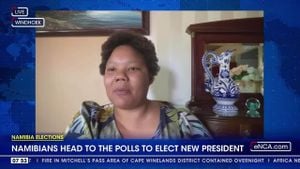Haircuts have long been a topic of conversation, not just about style, but about economics. Specifically, the difference in pricing between men’s and women’s haircuts has sparked considerable debate, as many women find themselves paying significantly more for seemingly similar services. A closer examination reveals that much of this disparity could be attributed to long-standing industry practices and societal perceptions that may no longer hold water.
Data illustrates this divide starkly. In a recent report from CNN, the average cost of a women’s haircut in the United States hovered around $51.71, while men typically paid only $34.56. In regions like South Dakota, women spent up to $31.43, almost one and a half times more than the $21.59 men were charged for the cheapest haircut. Similarly, a survey conducted in the UK indicated that women spent an average of £31.99 ($40.80) for their haircuts, which is over twice the average £12.17 ($15.50) men paid for similar services.
This price difference is often justified by the services offered or the time taken. The National Hair & Beauty Federation (NHBF) suggests that women's haircuts are typically more complex than men’s. Chief executive Hilary Hall states, "Men tend to have shorter hair and require haircuts which are technically quicker to deliver." However, this rationale fails to acknowledge the fact that many women also opt for shorter hairstyles that can be equally straightforward.
Moreover, the experiences of women like academic Trish Greenhalgh highlight another troubling aspect: gendered pricing does not adequately account for the actual service rendered. Greenhalgh's experience at her local salon revealed a notable discrepancy — she was charged £37 for a cut that a male stylist later gave her for just £15. This raises a fundamental issue: should pricing be based on gender or the complexity of the haircut?
In tandem with this pricing conundrum, there is also a troubling trend of gender discrimination in the salon environment. Stories abound of women being outright refused service at barbershops. Actor Georgia Frost's experience bears witness to this, where she was told, "we don't do women here" at two different barbers. Such experiences reflect an entrenched bias that suggests barbershops are male-only spaces, undermining the rights of women to receive a haircut anywhere outside a salon.
The length of hair can complicate these discussions, but not always in the expected ways. Karen Waldron, owner of the unisex chain Cut UK, emphasizes that a one-size-fits-all approach isn't applicable. She notes her stylists are trained to perform diverse cuts, regardless of the customer's gender. The solution Waldron envisions hinges on a culture of inclusivity, stating, "It's only in the last five years that I've allowed women who come in with an absolute man's cut. We can't be fussy any more now there are so many barber-shops."
In response to these longstanding issues, some salons are reforming their pricing practices entirely. Gender-neutral pricing options are emerging, which aim to eliminate the stigma associated with gender-based rates. Salons like Bee Sweet in Denver eliminate gender-based pricing entirely, focusing instead on the service and the time invested. Stylist Dani Bee notes, "It has never made any sense to me that femmes and women have to pay more than men." This shift not only promotes fairness but also creates a more welcoming atmosphere for clients of all genders, including nonbinary individuals.
Notably, the hairdressing federation in Belgium has proposed charging based on time rather than gender. The initiative encourages salons to settle on a fee of €1.30 (£1.10) per minute. This radical idea represents a shift towards recognizing the value of the service rather than relying on outdated gender stereotypes. As noted by salon owner Charlotte Jacob, this change fosters equality among clients: "Whether you’re a man or a woman, you pay the same."
However, not every stylist is receptive to this notion. Some traditionalists argue that there are too many intricacies in female grooming compared to male cuts; a sentiment that some dismiss as outdated. Others, like stylist Hailey Grien, focus on the actual time taken per haircut as the primary factor influencing cost. Grien notes, "I can cut a men’s haircut in 15 minutes flat, whereas a woman, I could take 45 minutes to an hour tops." Though time may dictate pricing to some extent, this perspective reinforces the dated notion linking longer hair with higher costs simply based on gender.
Historical precedent has entrenched gendered pricing in the salon landscape, fostering what some term the "pink tax." The phenomenon where products and services marketed towards women bear higher price tags than identical or similar offerings for men. The broader implications of this practice extend beyond haircuts, calling into question gender equity in pricing across a range of consumer goods and services.
The ripple effects of addressing these discrepancies can extend into the broader social conversation about gender equality. By dismantling the practice of charging women more for haircuts based solely on gender, society takes a step toward leveling the playing field. Such changes invite fresh discussions about pricing based on merit and skill rather than outdated concepts of gender roles.
Even as these shifts begin to take root in some areas, the conversation surrounding gendered pricing is far from over. The wider public remains divided, with some women valuing the amenities and services offered at salons traditionally catering to them, while others express frustration over the prices they are charged. This ongoing dialogue is particularly vital in light of the economic implications of unequal pricing practices.
As consumers, advocacy groups, and businesses engage in these critical conversations, the hope remains to forge a more equitable future in the world of hairstyling. Perspectives continue to evolve, and as society slowly shifts in its views towards gender neutrality, it is essential to encourage practices that reflect modern values of equality and respect for all clients, regardless of their gender identity.
Ultimately, the way forward lies in the recognition that haircuts should be priced fairly based on the time and skill involved — not the gender of the individual receiving the service. By embracing a model of inclusivity, the beauty industry could not only shed the remnants of outdated practices but also redefine what it means to offer a haircut that celebrates individuality and expression without the weight of societal expectations attached to cost.



